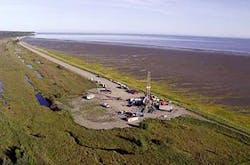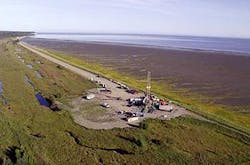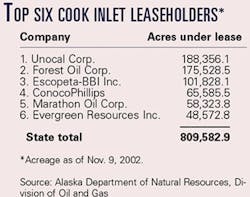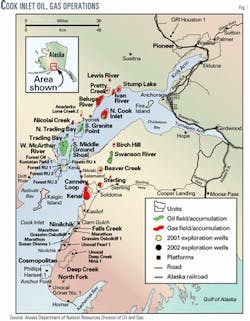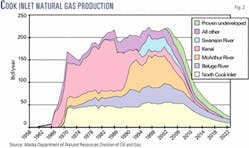A wave of independent oil and gas companies has swept into Alaska's Cook Inlet region in recent years.
Once rare even in this lower-cost of Alaska's two producing provinces—the North Slope and adjacent waters being the other—independents now dominate exploration and development action in this still-prospective region.
As with any maturing oil province, major oil and gas companies tend to pull back E&Dt efforts while independents move in and fill the void. Alaska has witnessed this trend, with the number of independents operating in the state having grown from about 6 companies 5 years ago to more than 20 independents today.
Cook Inlet changes
"Cook Inlet has changed. It has been a fairly rapid evolution from majors into the independents. The majors have decided to concentrate on the North Slope," said Ken Boyd, industry consultant and former director of the Alaska Department of Natural Resources' Division of Oil and Gas (DOG).
"Other companies, like (independent) Anadarko (Petroleum Corp.), have had some good success on the North Slope and are going to focus there. The Cook Inlet basin has now been explored for 45 years. I think the remaining prospects, and certainly there are some left, are probably just too small or perceived to be too small for the bigger companies. The bigger companies want bigger prospects, and of course, that brings you to the slope," Boyd said.
"Certainly on Cook Inlet, the majors have really begun to pull back," he said, adding that major operators such as Marathon Oil Corp. are still drilling some wells but not nearly as many as in previous decades.
Even Anadarko, a large Houston independent, is in the process of selling all of its interests in the Cook Inlet properties, Boyd said.
"Forest Oil (Corp., Denver), on the other hand, has moved in big time (see related profile, p. 24). They had some real success at their Redoubt Shoal prospect," he said. "They are drilling their fifth well there right now; it's going to be a substantial boost to Cook Inlet production.
"Other companies that are looking include Escopeta (Escopeta-BBI Inc., a Houston independent)…They claim they have reprocessed some seismic and will have a huge gas find when they drill the well next year….If they can get funding, I presume they will drill it. They believe very firmly in their processing of the seismic. What it would mean is that an awful lot of very long-experienced Cook Inlet players have overlooked that prospect. So, we will see," Boyd said.
Alaska DOG records confirm Escopeta-BBI is the third largest state leaseholder in Cook Inlet (see table).
Escopeta-BBI Pres. Danny Davis told OGJ that he is in the process of arranging for partners to help finance hiring a jack up, and he anticipates starting drilling in the summer of 2003. The company has two major prospects in Cook Inlet: East Kitchen, north of the East Forelands area of the Kenai Peninsula, and Kitchen, just off East Forelands.
Natural gas
Cook Inlet is an important natural gas province for nearby Anchorage.
"There is concern that as reserves decline, there are going to be peak-demand problems. In other words, on the coldest day of the winter, (suppliers) are not going to be able to meet the needs of the gas customers," Boyd said.
Summer gas demand is light and may never be a problem, he said.
"But peak demand could be a problem within, I think, 3 years, given current reserves. A number of companies have come in and said, 'We are going to meet that. We are going to find gas.' These are smaller companies. Aurora Gas (LLC) is an example," Boyd said of the Houston-based privately held company.
Bill Van Dyke, DOG petroleum manager, said that Cook Inlet still has potential, although the big oil fields found in the 1960s are in decline. Independents such as Forest Oil "are the bright side of the picture," he said.
Meanwhile, he sees gas production staying steady, although the areas where it is used could change in 8-10 years. Currently, one third of Cook Inlet gas is processed into LNG and shipped to Japan, one third is used to produce fertilizer, and one third is burned to produce electricity.
"Unless new (gas) supplies are brought online, it's not good news" for industrial gas users, Van Dyke said. "Folks are very actively looking for some new gas in the inlet. It's the first time in 30 years where you can see a gas crunch out there in the future," Van Dyke said. Within the last 2 years, companies have started exploring the inlet for gas for the first time in the last 20 years, he added.
Majors
While the latest flurry of exploration activity is dominated by independents, a few major oil and gas companies continue to maintain a strong presence in Cook Inlet
Marathon maintains its position as one of the largest natural gas producers in Cook Inlet, producing about 180 MMcfd of natural gas in Alaska during 2001. That was nearly 14% of the company's worldwide total production.
Marathon has explored the Cook Inlet region for more than 40 years, and its natural gas discoveries supply more than 60% of the Anchorage-area utility market. In recent years, Marathon entered into new basin assessments as a cooperative effort with several of Alaska's native corporations.
For instance, Marathon has acquired more than 600 miles of 2D seismic data and acquired a leasehold comprising nearly 14,000 acres through an exploration agreement with Cook Inlet Region Inc., an Alaska native corporation.
This acreage includes five prospects and two recent natural gas discoveries at Sterling Deep and Wolf Lake field within the Kenai National Wildlife Refuge. Wolf Lake was the first Cook Inlet gas discovery to be brought to market since 1979, and production started in November 2001.
Phillips Petroleum Co., now Conoco- Phillips, started exploring for oil in Alaska in 1952 and is Alaska's largest oil and gas producer. Its LNG plant in Kenai has supplied LNG to Japanese utilities for more than 30 years.
ConocoPhillips operates North Cook Inlet gas field, which provides its share of natural gas feed for the Kenai LNG plant. In 2001, net production averaged 129 MMcfd. ConocoPhillips also operates Beluga gas field, in which it holds a 33.3% interest. ChevronTexaco Corp. is a partner in that field. In 2001, Unocal's Beluga production totaled a net 39 MMcfd.
Unocal
The major operator in the Cook Inlet is no longer considered one of the major oil companies: Unocal Corp. shed the label of major some years ago when it divested all of its downstream interests to reposition itself as an E&D independent. But even this former major is lowering its profile in the inlet.
Unocal Alaska Resources—which has about 45 years of experience operating in the area and holds leases to 188,356 combined onshore and offshore acres —reported in mid-November that it is initiating a comprehensive restructuring program designed to improve the company's business profitability for the Cook Inlet area.
At the first of the year, Unocal Alaska operated 10 platforms in Cook Inlet and 5 of the 11 producing gas fields. Unocal Alaska's average net production during 2001 was 105 MMcfd of gas and 25,000 b/d of oil.
But things have changed since then and are still in flux.
A Unocal spokesperson said the restructuring was the result of a thorough analysis of Unocal's Alaska business unit. Financial reports show Unocal Alaska with a $6 million after-tax loss for the first quarter of this year, a $5 million loss for the second quarter, and a $29 million loss for the fourth quarter. The company made $102 million in the third quarter.
To preserve "the viability of the mature business," the company has shut in its Spurr platform and will shut in its Baker and Dillon platforms during the next few months. The latter two platforms have operated in Middle Ground Shoal field in Cook Inlet since 1965 and 1966, respectively. In addition, Unocal Alaska said it will close its Kenai office, relocating operations to Anchorage and other office locations on the Kenai Peninsula. The restructuring includes a reduction of 71 positions, which represent 18% of Unocal Alaska's total workforce.
"As we studied the costs, operations, and exploration opportunities, it became clear that to have a viable business in the Cook Inlet, we had to make significant changes now or face even more serious challenges in the future," said Unocal Alaska Vice-Pres. Chuck Pierce.
Unocal said it would continue to pursue "elective, focused, development and exploration projects to add incremental reserves and production." It also said it intends to retain its partner-operated working interests in Kuparuk River and Endicott fields and will continue its exploration activities on the North Slope.
Ninilchik optimism
There is one very bright spot in Unocal's dimmed Cook Inlet scenario, however. In January, Unocal and Marathon, under a joint operating agreement, discovered a new gas reservoir in the 25,000 acre Ninilchik Exploration Unit on the Kenai Peninsula with the Grassim Oskolkoff No. 1 well, which flowed 11.2 MMcfd on test from one zone. The discovery well is 35 miles south of the city of Kenai.
The discovery was followed by the successful completion and testing of two additional exploration wells in the unit. The Grassim Oskolkoff No. 2 well was tested at a combined flow rate of 11.9 MMcfd from three zones last spring, and the Falls Creek No. 1 RD also flowed from a single zone, at a rate of 6.8 MMcfd from pay at 8,714 ft. Ninilchik is estimated to contain more than 90 bcf of gross proven reserves.
Unocal holds a 40% working interest in the Ninilchik Exploration Unit, and Marathon is operator and holds the remaining 60% interest.
Ninilchik is expected to start producing in 2003, pending installation of a gas transmission pipeline.
Southern Kenai drilling
Unocal also said, however, that a related three-well drilling program on the southern Kenai Peninsula failed to encounter commercial quantities of natural gas. Activities were suspended on all three wells, with no plans for further evaluation. Unocal has a 100% working interest in those three wells.
Pierce said the company was "obviously disappointed in the results of the threeUwells." However, he said results from the Ninilchik Exploration Unit "are very encouraging. Our overall Kenai drilling program has met our initial range of projections. We intend to follow through with a Ninilchik unit development program and to aggressively pursue other exploration opportunities in the Cook Inlet area," he said.
The company said the net unrisked resource potential of the Ninilchik unit and additional prospects could be 100-600 bcf. By yearend, Unocal expects to have completed and tested eight wells on the trend—five in the Ninilchik unit, and three on the other Unocal prospects. "These wells have major implications for natural gas development of the southern Kenai Peninsula," Pierce said.
Kenai-Kachemak pipeline
Unocal and Marathon formed Kenai Kachemak Pipeline LLC to develop a 33 mile, 12-in. natural gas pipeline to connect the new natural gas supplies with the existing south-central Alaska pipe- line system. Originally planned as longer and with 16-in. and 12-in. pipe, the project was downgraded following news of the unsuccessful wells. Norstar Pipeline Co., a subsidiary of Anchorage utility Enstar Natural Gas Co.'s Alaska Pipeline Co., has been formed to operate the 120 MMcfd pipeline.
Upon completion of the $25 million, open-access pipeline, newly discovered resources would serve commercial and utility markets in south-central Alaska. Design work and permitting are under way, and first production is anticipated for late 2003.
"Based on the results of the Mara- thon and Unocal-operated programs, we expect to have sufficient gas resources to support construction of the proposed Kenai-Kachemak pipeline," Pierce said.
Unocal has two key customers—a long-term relationship with Calgary-based Agrium Inc. and a gas sales agreement initiated more recently with Enstar, with which Unocal signed a natural gas supply contract to provide as much as 450 bcf of natural gas beginning in January 2004. Enstar distributes natural gas to Anchorage, the Matanuska-Susitna Valley, and the Kenai Peninsula.
Charles R. Williamson, chairman and CEO of Unocal Corp., included the South Kenai gas project in four oil and natural gas development projects that he said would contribute to a 5-7% average annual growth in production, earnings, and cash flow for Unocal during the next 5 years.
Aurora Gas
Aurora Gas just completed some major acquisitions in the Cook Inlet area, which the company considers its core area of operations.
Most recently, Aurora Gas purchased the 50% working interest and leasehold held by ConocoPhillips Alaska Inc. in the Moquawkie area on the west side of Cook Inlet. Aurora also reached an agreement to acquire Anadarko's entire Cook Inlet leasehold, which included the remaining 50% of the same leasehold Aurora acquired from Conoco- Phillips.
The Moquawkie area holdings cover about 43,000 acres on Cook Inlet's west side. Surface land rights are owned by Tyonek Native Corp. The acreage includes the Lone Creek No. 1 discovery well, drilled in late 1998 by what was then ARCO Alaska Inc.
"Our primary interest was the Moquawkie area, and what we got from ConocoPhillips was exactly that—its 50% of the Moquawkie area," G. Scott Pfoff, Aurora Gas president, told OGJ. "When we approached Anadarko, they said they would be willing to sell the same assets, but they wanted to sell out of the entire Cook Inlet (area)," he said. "We see a lot of great potential on the east side of the inlet, but the west side of the inlet, which is where the Moquawkie area is, is what really is our focus and what we see as our real niche," he added.
Assuming these two transactions are consummated, Pfoff said that Aurora Gas would then hold about 100,000 net acres in the inlet, placing it among the top leaseholders in the area.
At the time that Aurora's acquisitions were being announced earlier this year, the company was rigged up on the west side of the inlet preparing to drill two reentry wells on its Nicolai Creek acreage.
Since then, the company has recompleted its NCU No. 2 well in three intervals at 2,476-2,916 ft and reentered and sidetracked its NCU No. 1A well, which is now called NCU No. 1B. That well was completed in three zones at 3,191-3,575 ft.
The company's newest well in the area, Nicolai Creek No. 8, which it had planned to drill before yearend 2002, was deferred until next year.
Underexploited region
Of the Cook Inlet area, Pfoff said, "It's basically a very resource-rich basin that's underexplored and underdeveloped.
"We had a flurry of activity in the 1960s; we had some very nice discoveries, and instead of going through the normal progression from there, the North Slope discovery was made, and everything went north," he recalled.
Even with basin operations being more than 40 years old, Pfoff said that it "really hasn't gone into the next phase that a normal oil and gas basin would go into." The company seeks to explore further, so that it can assess more of the midsized and smaller fields, some of which were found earlier. "While looking for oil, (other companies) found a lot of small gas pockets, but nobody ever developed them," he said.
Making things even better for operators in the area, he said, were two factors, the first being the transitioning of the natural gas market. "There were three or four very large gas fields discovered in the 1960s (while companies were) looking for oil, and those have provided all the needs for south-central Alaska for 40 years," Pfoff said, adding, "But those fields are finally starting to show their age, and so the market is transitioning from 'oversupply' to 'undersupply.'"
Secondly, the majors and large independents are losing interest in the basin, he said. "So there's relatively little competition (in the area) and we feel like we've got a pretty good head start on everybody else," he said.
Squeezing costs
Pfoff told OGJ that keeping costs down while operating in the Cook Inlet area is a challenge, but that Aurora tries to cut costs wherever it can.
On keeping costs down, Pfoff said, "It's been a struggle. But I think that the service companies are seeing that the independents are going to be the next wave of business for them and that we just have to have it if we are going to make these smaller fields work."
Earlier this year, Aurora purchased its own workover rig—a Franks 300 Series well servicing unit—because often the only rigs available in the area were full-blown drilling rigs, which Pfoff called "overkill," for a lot of the work that the company wanted done. Aurora partnered with Wyoming-based Boelens Well Service LLC and formed Aurora Well Services LLC to overhaul and refurbish the pulling unit. It was shipped to the area in June. "We put it on our reentries on the west side of Cook Inlet," Pfoff said.
Pfoff said that Aurora would spend $12-13 million in the inlet area in 2003, similar to what it spent in 2002. The 2002 number, however, includes the company's numerous acquisitions, he said. "Next year, none of (the budget) that I see is tagged for acquisitions, it's all for development and exploration activities," he said.
Cook Inlet exceptional for XTO
XTO Energy Inc. sidestepped its primary strategy of developing natural gas reserves in the Lower 48 to go for the oil underlying its Cook Inlet property, which accounts for a third of the company's total oil production.
But its northernmost holding is in keeping with the Fort Worth-based independent's policy of acquiring long-lived properties, usually from major operators, in major US producing areas—properties with geologically complex reservoirs and shallow rates of decline, where the company can use its expertise to reduce operating costs and increase production.
XTO Energy, formerly Cross Timbers Oil Co., acquired a controlling interest in Middle Ground Shoal field from Shell Oil Co. in 1998 at a "relatively cheap" price of about $45 million.
"We were actively looking to buy oil in 1998, and we looked at this Cook Inlet and some other properties that Shell wanted to sell," said Keith Hutton, executive vice-president of operations for XTO. "We passed on the other properties but decided to buy the Cook Inlet holdings because it was such a good deal. We decided that Shell had the two best platforms and the least developed field in Cook Inlet."
The first platform was installed in 80 ft of water following the Mar. 24, 1964, Alaskan earthquake, which was the most massive ever recorded in the US. As a result, the two platforms were designed and built with "more structural integrity," Hutton said.
Middle Ground Shoal field has a production decline rate of 7%/year, "probably the lowest in the inlet. It will still be producing for the next 20-25 years, when the other fields are gone," said Hutton.
He said the cost of lifting oil from the field is a surprisingly low $5/bbl. The oil is transported by pipeline to XTO's onshore facility and on to the Tesoro Petroleum Corp. refinery on the adjacent Kenai Peninsula.
Moreover, a deeper Jurassic horizon under the field's current production reservoir "gives us a shot" at additional production, Hutton said. Having a "backup" upper producing horizon through which to drill in search of additional production at a lower level is another favorite strategy at XTO, especially if it can do so by simply deepening an existing well.
The field has 450 million bbl of oil in place, with 120 million bbl produced so far. Its average production during the third quarter was 4,385 b/d, with 3,837 net to XTO.
Middle Ground Shoal field is a north-south trending anticline that is structurally complicated, especially on its west flank, and productive from multiple zones.
The field is separated by a crestal fault into an east and a west flank. The east flank has dips approaching 55° to the east. But its west flank is overturned and cut by at least three high-angle thrust faults, with dips of nearly 85° to the east. The extreme dip of those beds adversely affects the quality of seismic in the area (OGJ, Mar. 5, 2001, p. 42).
Two thirds of the oil in place is on the east flank, where Shell initiated a waterflood project in the late 1960s. But most current production is from the west flank, Hutton said.
XTO teamed with GeoQuest, a unit of Schlumberger Ltd., using the service company's virtual reality technology to map the field's complex subsurface with 3D data.
All available information concerning well locations, deviation surveys, and geologic marker tops was loaded into a project database. Cross-sections and structural maps of the field also were provided to the joint team.
Meanwhile, XTO is applying to Middle Ground Shoal the expertise in horizontal and directional sidetrack drilling that the company perfected in the Permian basin.
So far, the company has drilled eight horizontal high-angle sidetracks, with average initial production of 500 b/d and with 750,000 bbl of additional oil reserves per well.
XTO currently is drilling the C13-13 LN, its first well to test the east flank.
It also has converted three earlier wells to injection wells. Officials said they are converting wells to waterflood the west flank, which has not had such stimulation previously.
Hutton calculates that XTO has spent $25 million on development of Middle Ground Shoal field since it acquired a majority interest. He reckons annual cash flow from that field at $24-25 million. "Anyway you slice it," he said, "it has been healthy for the company."
Moreover, the operation provides XTO an important foothold in Alaska from which it might exploit other opportunities to acquire and develop oil and gas properties.
"Alaskan officials don't accept independents readily," Hutton said. "They're afraid an independent might not have the necessary equity to back a play up there. Now we're proving that we are a player in Alaska."
